How to increase your addressable programmatic audio audience
Benjamin MasseSeptember 10, 2024
Benjamin Masse, Chief Product Officer at Triton Digital, on how to apply audio insights to scale your programmatic strategy and increase audience addressability
The audio landscape is vast – there’s streaming, which is transmitted over the internet in real-time; then there is broadcast radio, which is traditional audio transmitted over electromagnetic waves through the air; and ultimately, there are podcasts, which are pre-recorded audio series that can be downloaded and are typically listened to on platforms like Apple Podcasts, Spotify and others.
Each of these audio formats is distributed differently across owned and third-party platforms, making it complicated to have a complete picture of who is tuning in and when – all valuable information for the publishers that want to increase their audience and for the advertisers who want to reach that target audience.
Audience insights, therefore, are made up of a lot of different sources and with uneven characteristics, meaning there’s an opportunity to improve the understanding of listeners you reach with your content.
So, what is an addressable audience?
In short, an addressable audience is a group of people who match the characteristics of someone who will engage with your content or advertising. To expand on your initial target audience profile and build out more characteristics, you need to have a better understanding of who is engaging with your audio content.
There are plenty of sources for listener data and they each play a role in getting to know your audience.
In an ideal situation, publishers have access to consented first-party data via an app that they control. First-party data is sourced via an environment that has more direct insight into who is listening because the user has registered on the site, created a profile, and provided demographic information.
If a publisher doesn’t have an app, then they build relationships with third-party apps such as TuneIn. However, it’s up to them to decide how much information they share
When it comes to streaming and podcasting, though, it’s not as simple. In the case of streaming, you know when someone is connected or disconnected. Publishers can receive the real-time signal and see the IP address, which can help initiate a listener profile, but ultimately you don’t get user-level insights. On the other hand, podcasts are distributed via RSS feeds, so you won't know if or when a listener consumes your content.
There are also other “walled garden” platforms for which there is zero feedback available via open standards for the publisher to pull the info from.
Maximise those insights with the right targeting tools
Establishing a direct connection with listeners in an owned environment will always reign supreme as the best way to get to know your audience. However, if you can’t, there are many solutions you can use to inform audience profiles – you just need to find the partners to help you achieve that.
Identity technology company ID5, for example, leverages a variety of consented signals provided by media owners to securely identify users without compromising privacy and data protection. Those signals are then used to build a listener profile.
Other alternatives also include partners, such as Signal Hill, that help provide survey-based audience data. Advertisers can append household info to expand on certain profiles through those types of data partnerships. This might include identifying a household with a higher education or one that indexes higher for home improvement purchasing intent.
The more data and audience insights at your fingertips, the more you know who your content is resonating with, and then you can apply those insights to scale your programmatic strategy and increase audience addressability.
Future-proof your strategy
The cookie apocalypse on Chrome has been averted but the horse is out of the stall – changes are happening in this industry every day and every company has to be prepared to handle a variety of methods to activate and measure campaigns. With this in mind, it’s just as critical to think beyond the next year and start planning for the next five, or ten years.
Across the globe, restrictive privacy laws put the spotlight back on contextual advertising. It’s a proven practice where brand and content are rightfully matched. At Triton, we see the ongoing value and importance of this for brands and that’s why we acquired Sounder, to offer contextual advertising at scale using the power of AI.
As more solutions to help increase audience targeting are introduced, brands need to remember that at the end of the day knowing your audience will be the key to scaling any growth efforts.
By Benjamin Masse, Chief Product Officer
Triton Digital
Triton Digital® is the global technology and services leader to the digital audio, podcast, and broadcast radio industries. Operating in more than 80 countries, Triton provides innovative technology that enables broadcasters, podcasters, and online music services to build their audience, maximize revenue, and streamline their day-to-day operations. In addition, Triton powers the global online audio industry with Webcast Metrics®, the leading streaming audio measurement service and Podcast Metrics, one of the first IAB certified podcast measurement services in the industry. With unparalleled integrity, excellence, teamwork, and accountability, Triton remains committed to connecting audio, audience, and advertisers to continuously fuel the growth of the global audio industry. For more information, visit www.TritonDigital.com.
